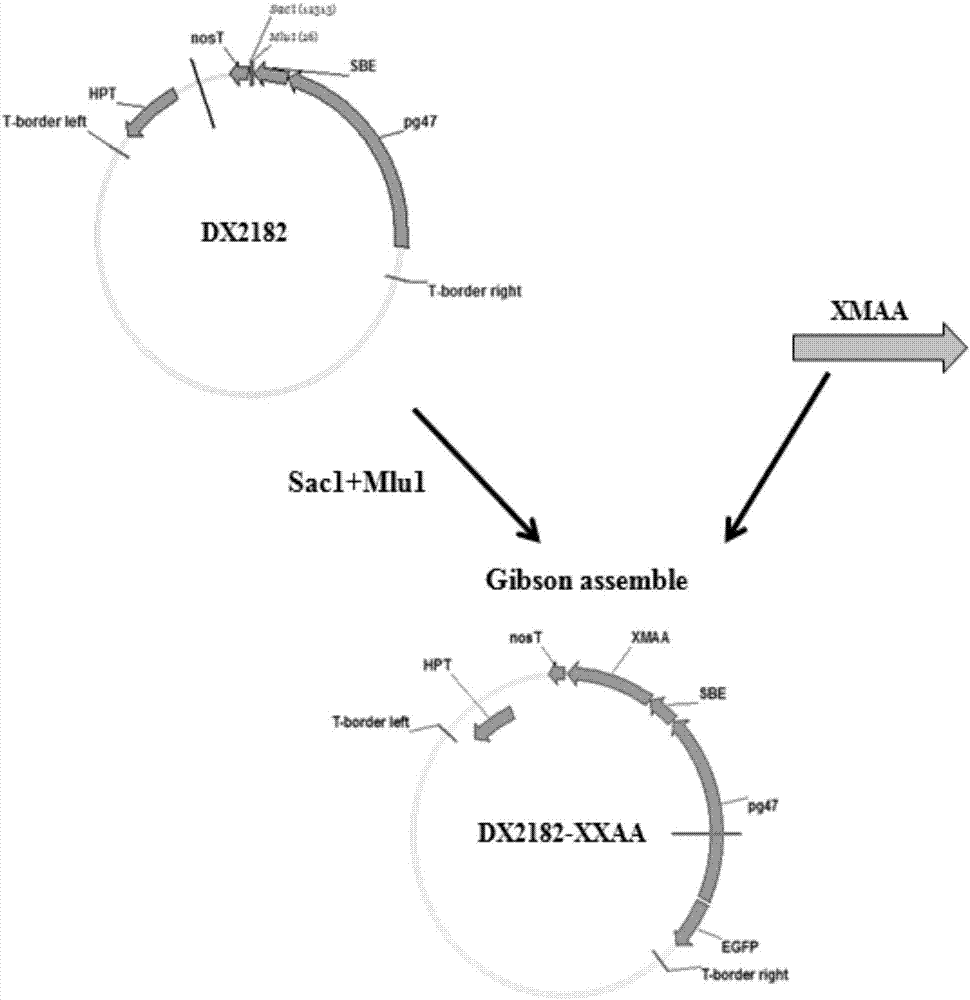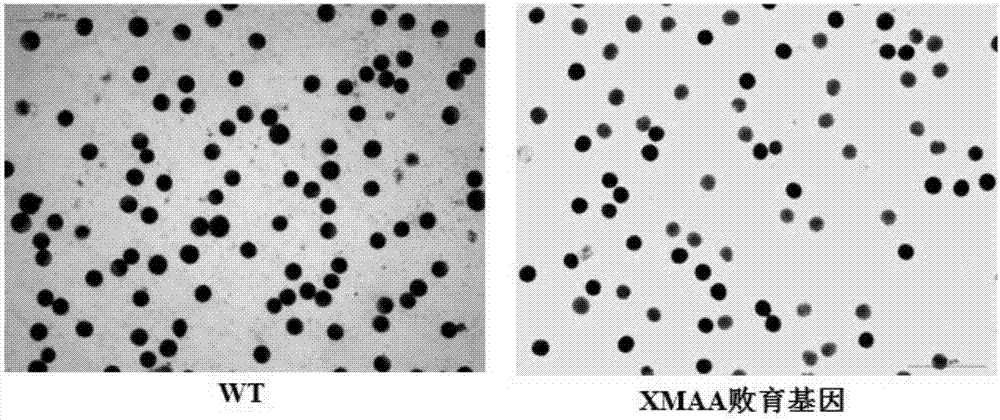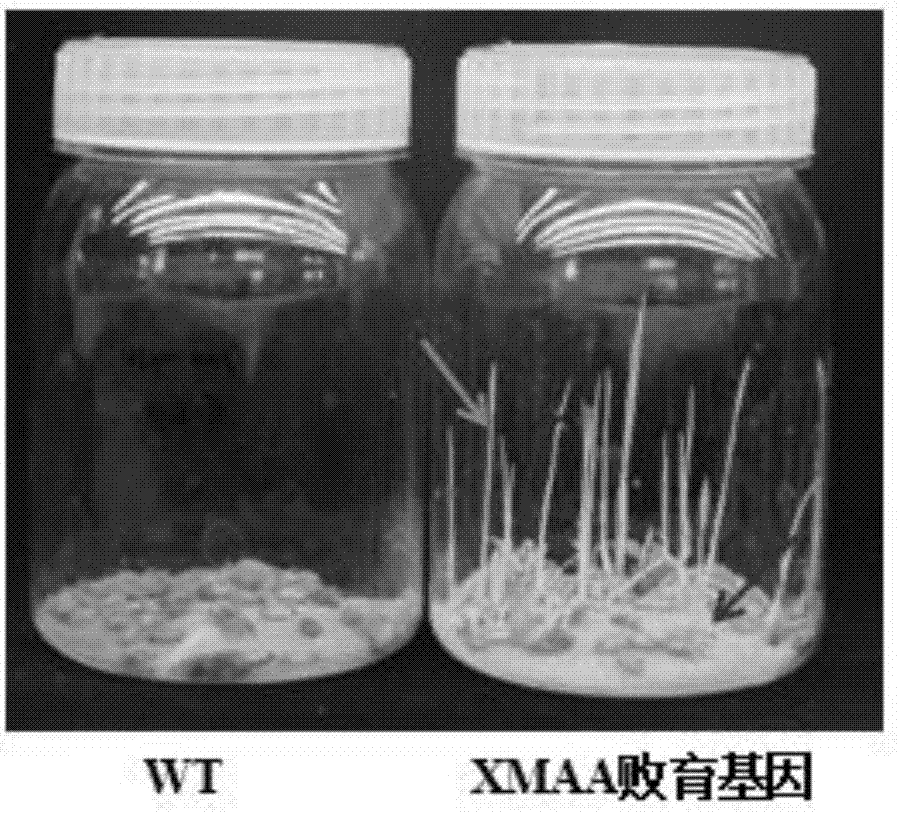Millet α-amylase and its coding gene and application
A technology of α-amylase and coding gene, which is applied in the fields of plant molecular biology and genetic engineering, can solve the problems of lower pollen energy metabolism, insufficient starch accumulation, and few reports, so as to save manual detasseling steps and maintain Precise effects on maintenance and reproduction, gene expression levels
- Summary
- Abstract
- Description
- Claims
- Application Information
AI Technical Summary
Problems solved by technology
Method used
Image
Examples
Embodiment 1
[0050] Example 1 Obtaining millet α-amylase gene
[0051] 1. Extraction of Xiaomi RNA
[0052] Use Biozol Reagent method to extract millet RNA: Weigh 0.1g of fresh millet ear tissue and 1ml BiozolReagent, mix well, and let stand for 5min at room temperature; add 0.2ml chloroform per 1ml Biozol Reagent, shake vigorously for 15s, wait until the solution is fully emulsified, and then Let stand at room temperature for 5 min, 12000 rpm, and centrifuge at 4°C for 15 min; carefully remove the centrifuge tube from the centrifuge, and transfer the supernatant to another new centrifuge tube; add an equal volume of isopropanol to the supernatant and invert the centrifuge tube upside down After mixing well, let stand at room temperature for 10min, 12000rpm, and centrifuge for 10min at 4℃; discard the supernatant, the tube wall can be white precipitate, add 0.5ml 75% ethanol (prepared with DEPC water after sterilization) to wash, invert and mix well Centrifuge at 10000rmp, 4℃ for 5min; repeat ...
Embodiment 2
[0071] Example 2 Construction of the recombinant expression vector DX2182-XMAA of millet α-amylase
[0072] See the build process figure 1 The vector DX2182 is pre-constructed with a male gamete preferential promoter PG47 with a sequence length of 2732 bp shown in SEQ ID No. 3 and a transduction peptide with a sequence length of 216 bp shown in SEQ ID No. 2. Insert the amplified product of Example 1 into the DX2182 vector Mlu1 and Sac1 restriction sites, which are the male gamete preferential promoter and the downstream of the transduction peptide.
[0073] The primers SEQ ID NO: 5-6 amplify the PCR product by 1% agarose gel electrophoresis to recover the product of about 1300 bp. The vector DX2182 was digested with Mlu1 and Sac1, and the linear digested vector was recovered.
[0074] The 2X ligation kit connects the abortion gene to DX2182, the 10ul system is as follows:
[0075] 2.5μ1α-amylase PCR product (50ng), 2.5μ1 digestion vector (100ng), 5μ1 Ligation Mix, ligation procedure:...
Embodiment 3
[0077] Example 3 Obtaining transgenic rice plants
[0078] Agrobacterium EHA105 stored at -70°C was streaked on a plate containing Kan (50μg / ml) + Rif (25μg / ml) + streptomycin (50μg / ml) and cultured at 28°C. Pick a single colony and inoculate it in 50ml YEB liquid medium, shake culture at 220rpm 28℃ for 12-16hr. Take 2ml of bacterial solution and transfer it to 100ml (containing antibiotics) YEP liquid medium, and shake culture to OD at 28℃ and 220rpm 600 = 0.5. Pre-cooling on ice for 10 minutes, 5000 rpm for 10 minutes (refrigerated centrifuge is pre-cooled to 4°C). Wash twice with sterile deionized water (10ml each time), wash once with 10% glycerol and dissolve it in 3ml 10% glycerol. Take 100 μl of competent cells plus 1 μl of the DX2182-XMAA plasmid obtained in Example 2, and transform with 2.5KV electric shock. Cultured on YEP culture plate containing kanamycin and rifampicin at 28°C, selected positive clones, and verified by PCR with DX2182-XMAA vector specific primer S...
PUM
 Login to View More
Login to View More Abstract
Description
Claims
Application Information
 Login to View More
Login to View More - R&D
- Intellectual Property
- Life Sciences
- Materials
- Tech Scout
- Unparalleled Data Quality
- Higher Quality Content
- 60% Fewer Hallucinations
Browse by: Latest US Patents, China's latest patents, Technical Efficacy Thesaurus, Application Domain, Technology Topic, Popular Technical Reports.
© 2025 PatSnap. All rights reserved.Legal|Privacy policy|Modern Slavery Act Transparency Statement|Sitemap|About US| Contact US: help@patsnap.com



